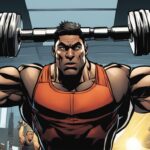The Ultimate Guide to dumbell workout
Did you know that incorporating dumbbell workouts into your exercise routine can have a significant impact on your overall fitness and strength? Weight lifting with dumbbells is a highly effective way to build muscle, improve your posture, and enhance your physical performance.
Whether you’re a beginner looking to start your fitness journey or an experienced lifter wanting to take your training to the next level, this comprehensive guide will equip you with the knowledge and exercises needed to optimize your dumbbell workouts.
Key Takeaways:
- Dumbbell workouts are an excellent way to build strength and muscle.
- Weight lifting with dumbbells can improve posture and physical performance.
- This guide is suitable for both beginners and experienced lifters.
- Stay tuned for in-depth explanations and step-by-step instructions on dumbbell exercises for upper and lower body.
- By the end of this guide, you’ll be empowered to design your own effective dumbbell workout routines.
Understanding Dumbbells for Weight Lifting
Before we jump into the workouts, it’s important to understand the basics of dumbbells. Dumbbells are versatile pieces of equipment that allow you to target specific muscles and vary the resistance for a well-rounded workout. Whether you’re a beginner or an experienced lifter, incorporating dumbbells into your routine can help you achieve your fitness goals.
There are different types of dumbbells available, each with its own set of advantages. Some common types include:
- Fixed-weight dumbbells: These are traditional dumbbells with a fixed weight that cannot be adjusted. They are available in a variety of weights, allowing you to choose the right one for your strength level.
- Adjustable dumbbells: These dumbbells have weight plates that can be added or removed to adjust the resistance. They are ideal for those who want the flexibility to increase or decrease the weight as they progress.
- Hex dumbbells: These dumbbells have a hexagonal shape, preventing them from rolling away when placed on the floor. They provide stability and are commonly used in gym settings.
Now, let’s talk about the benefits of using dumbbells. One major advantage is that they engage stabilizer muscles, as you have to control the weight in each hand independently. This helps improve overall balance and coordination. Additionally, dumbbell exercises mimic real-life movements more effectively compared to machines, making them great for functional training.
When choosing the right weight for your goals, consider your current strength level and the specific exercises you’ll be performing. Start with a weight that challenges you but still allows you to maintain proper form. As you progress, you can gradually increase the weight to continue challenging your muscles.
Remember, using dumbbells is not just about lifting heavy weights. Proper technique and form are crucial to prevent injuries and maximize results. Focus on maintaining control throughout the movement, engaging the target muscles, and avoiding any jerking or swinging motions. If you’re unsure about the correct form, consult a fitness professional or refer to reputable sources for guidance.
| Type of Dumbbell | Advantages |
|---|---|
| Fixed-weight dumbbells | – Easy to use – Available in various weights – Suitable for beginners – No adjustments required |
| Adjustable dumbbells | – Offers flexibility in changing weights – Saves space – Suitable for progressive training – Can be used for a wide range of exercises |
| Hex dumbbells | – Prevents rolling – Provides stability – Durable and long-lasting – Ideal for heavy lifting |
Essential Dumbbell Exercises for Upper Body
Welcome to the third section of our ultimate guide to dumbbell workouts! In this section, we will focus on strengthening your upper body using dumbbells. Incorporating these exercises into your routine will help you build muscle and increase your overall upper body strength, giving you the confidence and power you desire.
Dumbbell Press
The dumbbell press is a great exercise for targeting your chest, shoulders, and triceps. To perform this exercise:
- Start by lying flat on a bench with a dumbbell in each hand, palms facing forward.
- Position the dumbbells at shoulder level, slightly wider than shoulder-width apart.
- Press the dumbbells upward until your arms are fully extended, and then slowly lower them back down to the starting position.
- Repeat for the desired number of reps.
Remember to maintain proper form throughout the exercise and avoid arching your back excessively.
Bicep Curls
Bicep curls are a classic exercise that target your biceps and help you achieve well-defined arms. Here’s how to perform bicep curls:
- Stand with a dumbbell in each hand, arms fully extended along your sides, and palms facing forward.
- Curl the dumbbells upwards, keeping your elbows close to your body, until your forearms are perpendicular to the ground.
- Slowly lower the dumbbells back down to the starting position.
- Repeat for the desired number of reps.
Engaging your core and maintaining a stable upper body will maximize the effectiveness of the exercise.
Shoulder Press
The shoulder press is a fantastic exercise for targeting your shoulders and upper back. Follow these steps to perform a proper shoulder press:
- Sit on a bench with a dumbbell in each hand, palms facing forward, and your feet firmly planted on the ground.
- Begin with the dumbbells at shoulder level, elbows bent at 90 degrees.
- Press the dumbbells upward until your arms are fully extended.
- Slowly lower the dumbbells back down to the starting position.
- Repeat for the desired number of reps.
Keep your core engaged, and avoid using momentum to lift the dumbbells. Focus on controlled and deliberate movements.
To give you a visual representation of these exercises, take a look at the image below:

| Exercise | Muscles Targeted |
|---|---|
| Dumbbell Press | Chest, Shoulders, Triceps |
| Bicep Curls | Biceps |
| Shoulder Press | Shoulders, Upper Back |
Now that you have learned some essential dumbbell exercises for your upper body, it’s time to incorporate them into your workout routine. Remember to start with lighter weights and gradually increase as you build strength. Stay consistent, stay dedicated, and watch your upper body transform!
Effective Dumbbell Exercises for Lower Body
Now it’s time to shift our focus to the lower body. In this section, I’ll guide you through a range of exercises using dumbbells that specifically target your legs, glutes, and hips. These exercises are designed to help you build strength, increase muscle tone, and enhance overall lower body performance.
1. Squats
Squats are a fundamental lower body exercise that engages the muscles in your thighs, hips, and glutes while also strengthening your core. To perform a dumbbell squat:
- Stand with your feet shoulder-width apart, holding dumbbells at your sides.
- Lower your body by bending at the knees and hips, as if you were sitting back into a chair.
- Keep your heels flat on the ground and your chest lifted.
- Pause briefly at the bottom before pushing through your heels to return to the starting position.
2. Lunges
Lunges are a fantastic exercise for targeting the muscles in your legs, including your quadriceps, hamstrings, and glutes. To perform a dumbbell lunge:
- Stand tall with dumbbells in each hand, palms facing your sides.
- Step forward with your right foot, lowering your body until your front knee is at a 90-degree angle.
- Keep your front knee aligned with your ankle and your back knee hovering about an inch above the ground.
- Push through your front heel to return to the starting position and repeat on the other side.
3. Hip Thrusts
Hip thrusts are an excellent exercise for targeting your glutes and strengthening your hip muscles. To perform a dumbbell hip thrust:
- Start by sitting on the ground with your upper back against a bench and your feet flat on the floor.
- Place a dumbbell on your hips, holding it in place with your hands.
- Engage your glutes and lift your hips off the ground until your body forms a straight line from your knees to your shoulders.
- Hold the position for a moment before lowering your hips back down and repeating the movement.
These exercises will help you develop strength, stability, and definition in your lower body. Remember to choose weights that challenge you without compromising your form, and gradually increase the weight as you become stronger. Incorporate these exercises into your dumbbell workout routine to achieve an impressive lower body transformation.
| Exercise | Muscles Targeted | Difficulty Level |
|---|---|---|
| Squats | Quadriceps, Hamstrings, Glutes | Intermediate |
| Lunges | Quadriceps, Hamstrings, Glutes | Beginner |
| Hip Thrusts | Glutes, Hamstrings, Hip Muscles | Advanced |
Conclusion
Now that you’ve reached the end of the ultimate guide to dumbbell workouts, you have all the tools you need to create an effective weight lifting routine. By incorporating dumbbell exercises into your fitness regimen, you’ll be able to target specific muscles and achieve significant gains in strength and muscle mass.
Remember, when starting out, it’s important to begin with lighter weights and focus on maintaining proper form. As you gain confidence and strength, gradually increase the resistance to continue challenging yourself. Consistency is key when it comes to seeing results, so make sure to prioritize regular workouts.
With the wide variety of dumbbell exercises available, there are endless opportunities to mix and match movements that align with your goals. Whether it’s building a powerful upper body or sculpting strong legs, dumbbell workouts allow for versatility and customization.
So, don’t wait any longer – grab those dumbbells, push yourself, and watch as you reach new fitness heights. Incorporate dumbbell workouts into your weight lifting routine, and see the ups in strength and muscle growth that you’ve been striving for!
FAQ
What are the benefits of dumbbell workouts?
Dumbbell workouts offer various benefits, including increased muscle strength, improved muscle balance, enhanced coordination, and the convenience of working out at home or in a gym with limited equipment.
Can dumbbells help with weight loss?
Yes, dumbbells can be highly effective for weight loss. When incorporated into a well-designed workout routine, they can increase your metabolism, burn calories, and help you build lean muscle mass, which in turn aids in fat loss.
How heavy should my dumbbells be?
The weight of your dumbbells depends on your fitness level and the exercises you intend to perform. As a general guideline, beginners can start with lighter weights, around 5-10 pounds, while more advanced lifters may opt for heavier weights, ranging from 15-30 pounds or more.
How often should I do dumbbell workouts?
The frequency of your dumbbell workouts will depend on your goals, fitness level, and schedule. For beginners, 2-3 sessions per week is a good starting point. As you progress and become more comfortable with the exercises, you can gradually increase the frequency to 4-5 sessions per week.
Can I target specific muscles with dumbbell exercises?
Absolutely! One of the greatest advantages of dumbbell exercises is the ability to target specific muscles. By using different dumbbell exercises and variations, you can focus on specific muscle groups such as the chest, arms, back, shoulders, legs, and core.
Should I consult a professional before starting a dumbbell workout routine?
If you’re new to weightlifting or have any pre-existing health conditions, it’s always a good idea to consult with a fitness professional or your healthcare provider before starting any new exercise routine. They can assess your fitness level, provide guidance on proper form, and help you create a workout plan tailored to your needs.
